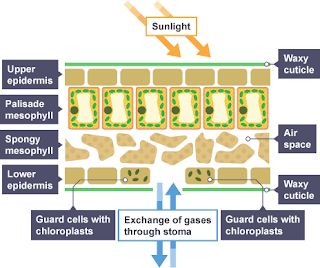(e) nutrition
1/12
Earn XP
Description and Tags
Name | Mastery | Learn | Test | Matching | Spaced |
|---|
No study sessions yet.
13 Terms
photosynthesis, equations, factors, leaf structure and adaptations [flowering plants] (2.18 / 2.19 / 2.20 / 2.21)
light energy from the sun is absorbed by chlorophyll to produce glucose (stored as starch for growth) and oxygen (as a waste product)
equations:
carbon dioxide + water →(sunlight and chlorophyll)→ glucose + oxygen
6CO2 + 6H2O →(sunlight and chlorophyll)→ C6H12O6 + 6O2
factors that affect the rate of photosynthesis:
carbon dioxide
as carbon dioxide concentration increases, the rate of photosynthesis will increase
since carbon dioxide is a reactant involved in photosynthesis, a heightened concentration of it will allow more photosynthesis to occur
however, the rate of photosynthesis will eventually plateau due to another limiting factor even if the concentration of carbon dioxide continues rising
temperature
as the temperature gets nearer to the optimum, the rate of photosynthesis will increase
this is because the closeness of temperature towards the optimum will allow for optimum enzyme activity, hence increasing the rate of photosynthesis
however, if the temperature increases too far above the optimum, the enzymes involved in photosynthesis will denature, causing the rate of photosynthesis to decrease
light intensity
as light intensity increases, the rate of photosynthesis will increases
since photosynthesis can only occur when light is present, an increase in light intensity will allow more photosynthesis to occur
however, the rate of photosynthesis will eventually plateau due to another limiting factor even if the light intensity continues rising
structures of the leaf:
waxy cuticle
prevents loss of water by evaporation + prevents entry of disease-causing microorganisms
upper epidermis
palisade mesophyll
spongy mesophyll
lower epidermis

[flowering plants] (2.22)
[flowering plants] (2.23)
[humans] (2.24)
[humans] (2.25)
[humans] (2.26)
[humans] (2.27)
[humans] (2.28)
[humans] (2.29)
[humans] (2.30)
[humans] (2.31)
[humans] (2.32)
[humans] (2.33B)